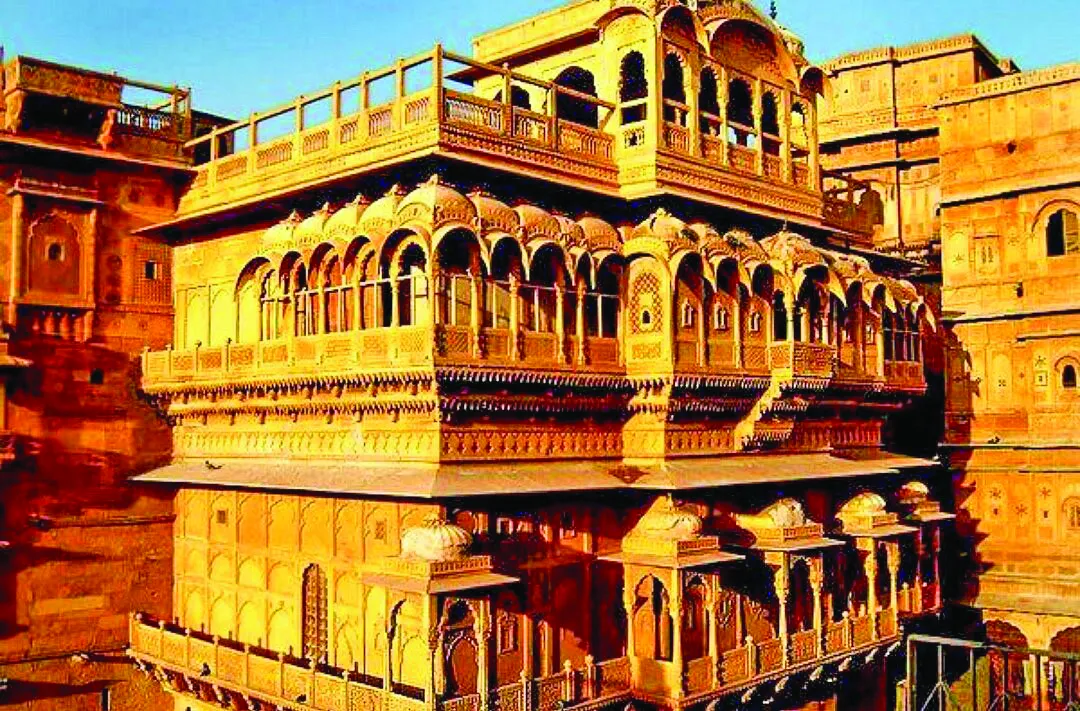Ever since I shifted to my ancestral village, Meja, a few years ago after a long stint in Mumbai, I began to realise that one of the best things about residing in rural Rajasthan in the scorching heat of April is that you get to witness the fortnight-long festivities of Gangaur in all its pomp and pageantry. The celebrations commence with the advent of the Chaitra month of the Hindu calendar and continue for eighteen days culminating on Teej.
Each year, from the day following Holi, the corridors of Meja Fort resonate with the laughter of giggly village girls who arrive here straight after school carrying festive garments in their school bags. More giggles and quick makeovers later, these excited teenagers step out donning vibrant “ghaghra-odnis” gorgeously accessorised with colourful bangles and ethnic jewellery. Singing the Isar-Gangaur song in perfect harmony, they gather around and pray to the pindiyas—round-shaped figurines made with ashes of the Holi pyre considered to be symbolic representations of Gangaur.
Elaborating upon this tradition, my grandmother Maaji Saheb Hansa Kumari of Meja explains, “Gan signifies Lord Shiva or Isar Ji and Gaur denotes Gauri or Goddess Parvati. Gangaur is revered as the perfect embodiment of conjugal bliss so women pray to her for marital accord and unmarried girls pray with the hope of being blessed with ideal life partners.” The pragmatist in me knows that these prayers may or may not be answered, but the optimist in me silently prays along with them, hoping their wish is granted. As my grandmother says, “Hope can be a powerful force. When you hold onto hope like a light within yourself, the universe sometimes conspires to make things happen—almost like magic.”
Echoing my grandmother’s sentiments is Rani Manjushree Kumari of Bhadrajun who has been diligently doing the Gangaur puja since her adolescence. She likes to believe that divine intervention may have played its part in finding her a perfect match in Raja Karanveer Singh Ji about three decades ago. “I used to pray to these tiny idols of Isar-Gangaur at my parental home for years. When I got married, I brought them along from Poogal-Bikaner to Bhadrajun. Each year, I pray before them throughout the festival, and on the last day, I pray to the big ancestral idols along with family and the people of our village.”
Public participation has always been an integral part of this festival and people come together irrespective of their social milieus to celebrate one of the most revered female divinities. The eve of Gangaur holds special significance for the potter community as they are visited by a pageant of women dolled-up in fineries accompanied by local musicians to bring home the ladolas or clay idols of Isar-Gangaur. The procession receives a grand welcome on return to the forts and palaces across Rajasthan followed by an evening of festive revelry.
“The final day begins with the puja of the clay idols with sprouted jowar (sorghum) germinated over a fortnight at home,” says Kawarani Rudrangda Kumari of Kankarwa. “An array of ornaments gets made for the Gangaur using besan (gram flour dough) and it is rather intriguing to see pieces of traditional jewellery from head to toe like the tevta (a regal neckpiece), rakhdi (a spherical maangtika), bajubandh (armlets), paijeb (anklets), etc, being created with such an unusual ingredient. The last day is considered the day of Gangaur’s departure from her parental home to her husband’s abode, so this jewellery forms a part of her trousseau.”
Most noble families have their ancestral idols passed down through generations and many of them have captivating stories attached to them. Rani Sugan Kumari of Bedla shares the fascinating history of her family’s fragmented Gangaur whose body was damaged during a battle many years ago and what remains is just the head. “The idol cannot be repaired as per tradition but it is dressed in a way that its disability is not revealed and reverently worshipped year after year.”
Baisa Swati Kumari of Chanoud narrates an interesting tale about a century-old miniature Gangaur in the possession of her family. “We have the regular size wooden idols just like other noble families but our mini-Gangaur was fashioned more than a hundred years ago exclusively for the convenience of little girls to pray during the festival.” The silver coating embossed on this idol has withered with time but the delicate figurine glazed with natural colours beautifully adorns a stone niche at Chanoud Fort even today.
Another anecdote that deserves special mention is about the Gangaur of Kota which was tactfully stolen by Kunwar Lal Singh of Gogunda on being challenged by the Maharana of Mewar. Rajrana Rohitashva Singh relates how his ancestor appeared before the Maharaja of Kota disguised as a skilled rider who could make the wooden Gangaur dance on his horse. “Once he got hold of the Gangaur, he heroically escaped from there and presented it to Maharana Saab on return. Rewarding his daring act, MaharanaSaab asked him to retain this Gangaur at Gogunda. This idol remains a major attraction during our procession every year.”
Processions are carried out throughout the state on the last day of the festival for which the idols are dressed in ceremonial poshaks and traditional ornaments. They are first seated in the zenana chowk where women offer their prayers and later brought out in the mardana chowk where the men seek their blessings. While the women indulge in ghoomar, men perform the gair dance—a local equivalent of the dandiya. Certain families enact the entire wedding ceremony between Isar and Gangaur. Rani Kavita Kumari of Kharwa reveals how their family’s sole Isar weds their two Gangaurs each year completing four pheras with one idol and three with the other!
After the initial ceremonies at the royal residences, the processions head out in the respective villages. One of the most distinguishing characteristics about the Gangaur procession in Mandawa is that parallel celebrations take place in the abodes of the kingdom’s two founders Padam Singh Ji and Gyan Singh Ji, as accounted by Thakurani Manjul Kumari of Mandawa. “There have always been two sets of Isar-Gangaurs which are taken out every year for the procession. Care is taken to ensure that neither one of them is even slightly ahead of the other. In earlier days, this was reason enough for swords to be drawn and a skirmish to take place!”
In its last lap, the regal spectacle passes through lanes and by-lanes of the villages accompanied by colourful dancers, indigenous musicians and a sparkling display of fireworks. Making a final halt at a nearby lake or pond, the convoy performs the puja one last time before immersing the eco-friendly clay idols—the pindiyas and ladolas in water. This signifies Goddess Parvati’s farewell to Lord Shiva’s abode from her parental home. As emotional songs of vidaai reverberate under starlit summer skies, heavy hearts and tearful eyes lovingly bid adieu to the dissolving effigies of Gangaur, while the tangible wooden idols return to their chambers in the forts and palaces to hibernate for the next twelve months.























